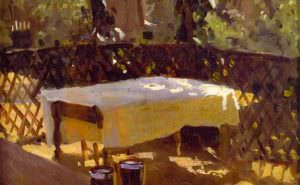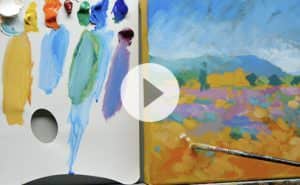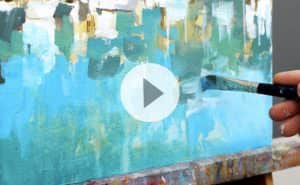
As a beginner landscape painter, it’s easy to feel overwhelmed by the vastness of nature and the complexity of capturing it on canvas. But when you break down the scene into shapes, values and planes, you can instantly improve the sense of depth and realism.
In last week’s post, we looked at the theory of angles and how they relate to a landscape.
This week, we’re going to put the theory into practice.
By stripping away the colour, it will be easier to see how the value relationships work in our subject.
Materials you will need:
- 4 x 4-inch or 6 x 6-inch square canvas board or canvas paper
- Neutral Grey Acrylics (Golden Paints)
- Titanium White Acrylic
- Palette Knife
- Round Brush. Rosemary & Co, Size 4, Series 344
- Square brush. Rosemary & Co, Size 12, Series 302
- Pencil or Acrylic marker to draw out.

Step 1: Understanding Carlson’s Four Planes of the Landscape
To master landscape painting, it’s crucial to understand Carlson’s Four Planes of the Landscape. These planes are —sky, ground, slanted, and upright—and they serve as your compositional building blocks.
Step 2: Draw Out the landscape
I’ve drawn out the main shapes of the landscape with an acrylic marker. This is by Daler Rowney, and I’ve filled the empty marker with Sepia High Flow Ink. Make sure to keep the spaces between the trees. These negative spaces allow for dashes of sunlight.

Here’s a 6 x 6 inch (15cm x 15cm) version of the drawing you can download: landscape drawing reference image
Step 2: Block in Your Upright Plane
Asking the question, ‘What angle is this object facing in relation to the light source?‘ can help you group the subjects. So, if we look at the trees, they are growing vertically, so they would fit within the upright plane. This faces away from the light source, so it is the darkest value.

I’m using a round brush and an N2 neutral grey.

I’m using pre-mixed greys for speed, but you can mix your own grey using Black and Burnt Umber, or Ultramarine and Burnt Umber.

I dip the brush into water and use that to alter the consistency of the paint.
If I feel the brush dragging a little on the canvas surface, I add a touch more water.
I’ve also got a piece of kitchen roll to the side. I can dab the bristles onto the paper towel if the brush contains too much liquid or pigment.
Step 3: Paint in the slanted plane

I’m still using the round brush, but jump up to the next lightest value for the slanted plane. This is for areas of the painting facing away from the light, but not fully exposed to the sun, so usually within the mid values.
It could be a hill in the distance, a roof, or a mass of leaves. On trees, you’ll often have the trunk as an upright plane, but the top of the leaves grow out at a slanted angle so they receive more light.
I’m using a few different greys and tweaking the values between them.

Neutral Grey from Golden Acrylics
Step 4: Paint in the Ground Plane

Once the slanted plane is in, I swap to a larger square brush to paint the ground plane.
This is much lighter than the slanted plane but not as bright as the sky. This area is often lighter in value than you think it should be.

Step 5: Paint in the Sky plane (light source)
We can jump to the lightest value, sky plane, for the light source of the sky. I’m using the square-edged brush and the corner of the bristles to paint in the sky holes. This helps to move the viewer’s eye across the painting and completes the value hierarchy.

I swap to the round brush for the final details of the gaps between the trees.

By understanding and applying Carlson’s Four Planes of the Landscape, you can break down complex scenes and create beautiful, realistic landscapes. Remember to start with a simple sketch, look for the shapes that are grouped together, and maintain consistent lighting variety.
You can watch a short 1min 30 video of the steps on YouTube below:
You might also enjoy:
1.How to simplify a complicated Landscape Scene
2.How to Paint Greens in Acrylics





This is so helpful! You always are–and fun to read, too.
Glad you enjoyed it Barbara
Thanks for your tips & sharing your knowledge. I always learn something from your posts!
So pleased you enjoyed it Ann
Brilliant course, thanks so much for sharing all this info, Will!
Thanks Jenny
Hello Will,
I especially love black and white painting. I’m looking forward to trying this. How does it work then with color? Seems it could get quite complicated.
Hey Laura, you can translate the method just by mixing base colours in the different values. In fact you’ve inspired a new tutorial! You can see it here:How to Paint a Realistic Landscape (With Only 4 Colours) and watch a demonstration with colour.
Cheers,
Will
I’ve been saving your posts for years. I’m so totally blocked on my visual art since a car accident resulting in a TBI. (Traumatic Brain Injury) 24 years ago. This short video is the first one I’ve actually watched.
It was great! Thank you Will.
I hope the next step is trying to get organized to paint again.
Hey Rachel,
I’m really touched to hear that my video has had such a positive impact on you, especially after facing such challenging obstacles. Getting organized to start painting again sounds like a great next step. Wishing you all the best on this journey, and remember, creativity can flourish in the most unexpected ways.
Take care,
Will